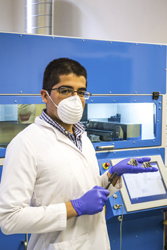Enhanced additive manufacturing
Additive manufacturing (AM) technologies refer to a family of processes that essentially build a component from the bottom up. Material is added in successive layers rather than removed from a block piece using specifications from a computer-aided design (CAD) model and programme. The result is complex 3D shapes with excellent surface quality, high feature resolution and precision, minimal post-processing and almost no scrap. Lithography-based AM technology employs liquid photopolymerisable resins that are solidified with light. Recent advances have yielded high-performance, cost-effective light sources as well as novel photocurable resins. Building on these technologies, scientists developed an integrated process chain for lithography-based AM of photopolymer-based systems with EU funding of the project 'Photopolymer based customized additive manufacturing technologies' (PHOCAM). Researchers employed digital light processing (DLP) and two-photon polymerisation (2PP) to overcome issues with inadequate mechanical properties and low resolution faced by current AM technologies. DLP was used to process ceramic-filled photopolymers for fully dense ceramic products. 2PP was employed in fabrication of small, high-resolution features on the scale of 100–200 nanometres (nm). For both technologies, the team developed suitable materials, hardware, software and the associated light sources. Ceramic processing with DLP used novel light-emitting diode-based light engines. 3D-printed ceramic parts had excellent strength, reliability and surface quality. 2PP relied on a commercially available femtosecond laser. The process chain includes a prototype web platform covering the entire workflow from geometric CAD model uploading to quote calculation, ordering and payment. Thread guides for textile machinery, a high-precision lattice mould for production of a computed tomography device and a patient-specific middle ear prosthesis showcased the novel AM technologies. Several press releases promoted project achievements on the international scene. PHOCAM successfully proved the industrial viability and quality of their technologies with major progress in on-demand micro-manufacturing and significant improvements in throughput and feature resolution. The fully integrated supply chain for cost-effective AM in a variety of sectors will positively impact EU manufacturing of high-throughput as well as customised components.







